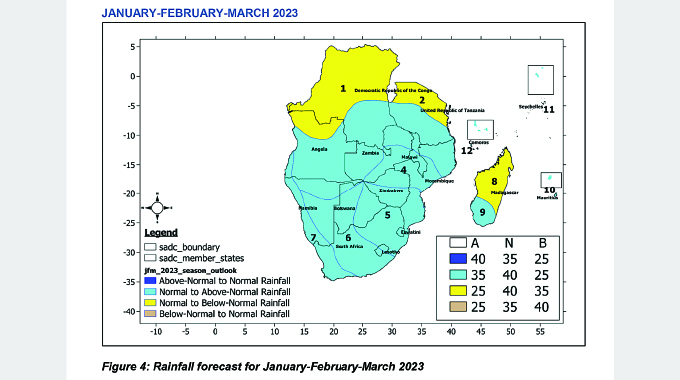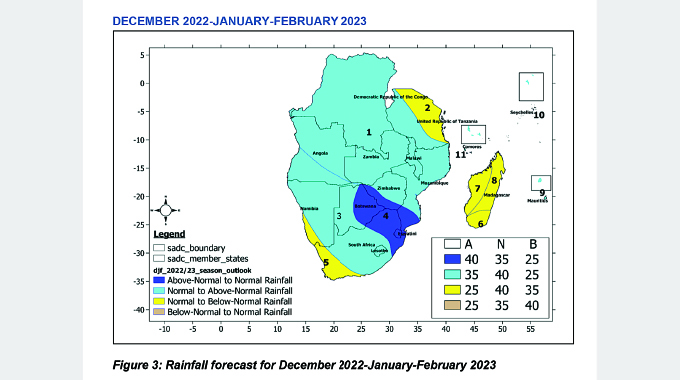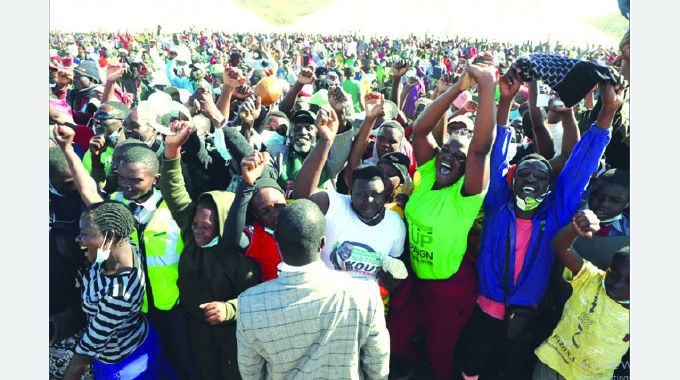Above normal rainfall forecast

Sifelani Tsiko
Agriculture, Environment & Innovations Editor
Most parts of Southern Africa are expected to have normal to above-normal rainfall in the coming summer cropping season, especially the southern and central areas, which include Zimbabwe.
The latest forecast by climate experts at the 26th Southern African Regional Climate Outlook Forum (SARCOF) held virtually and chaired by the Democratic Republic of Congo (DRC) showed that there was greater potential for normal to above normal rainfall for the bulk of the region, ushering an opportunity for good agricultural performance.
The possibility of flooding in some parts presented risks that require adequate preparedness and contingency planning.
SARCOF 26 was held under the theme: “Early warning and early action: SADC region preparedness towards a ‘ready-set-go!”
The favourable rainfall forecast comes as Presidential Inputs under the Pfumvudza/Intwasa programme are now at GMB depots across the country, awaiting distribution to farmers.
The Pfumvudza/Intwasa inputs, which are expected to benefit 3,5 million households this year, will be distributed according to agro-ecological regions in a development expected to boost yields.
Last season had a similar forecast, matched by the rainfall, but showing limitations of the long-range forecast in that the erratic nature of the rainfall could not be predicted in advance, only the totals.
The forecast for the next season shows the whole of the southern two-thirds of SADC, including Zimbabwe, should have normal to above normal in the first three months, with normal to below normal in northern Zambia and Malawi going north.
The second-half of the season sees the line between above and below normal moving further north with all of Zambia and Malawi along with southern Tanzania now in the above normal area.
“Bulk of the SADC region is likely to receive normal to above –normal rainfall for most of the period October to December 2022 with north-western part of Angola, bulk of DRC, Tanzania, northern Zambia, northern Malawi, Northern Mozambique, Comoros, Madagascar, Mauritius and Seychelles where normal to below normal rains are expected,” said the SARCOF 26 statement.
“The January to March period is expected to have normal to above normal rains in most of the region except for northern Angola, bulk of DRC, northern half of Tanzania and bulk of Madagascar.”
Experts said the outlook is only relevant to seasonal — overlapping three-monthly — time scales and relatively large areas and may not fully account for all factors that influence regional and national climate variability.
Users were advised to contact national meteorological and hydrological services for guidance and updates.
“The climate scientists took into account oceanic and atmospheric factors that influence the climate over the SADC region including the El Nino-Southern Oscillation which is currently in a La Nina phase.
“The ENSO is projected to remain in a La Nina phase during the forecast period,” said the climate experts in a statement.
Central Mozambique, southern Malawi, northern half of Zimbabwe, most of Zambia, southern DRC, south-eastern half of Angola, bulk of Namibia, western half of Botswana, most of central and western parts of South Africa and western parts of Lesotho have increased chances of normal to above–normal rainfall throughout the farming season.
Climate experts at the forum warned that increased chances of normal to above-normal rainfall could lead to flooding in flood prone areas, increased plant and livestock diseases and destruction of crops in some areas.
They urged farmers to avoid planting in flood prone areas, to grow disease tolerant varieties, practice rain harvesting and adopt appropriate water retention structures to control floods.
Improving drainage for excess water was also critical, they said.
In addition, climate experts said there was the likelihood of flash floods, increased flows into reservoirs and turbulent river flows which could lead to increased dam siltation and a possibility of damage to low cost dam infrastructure.
“For hydro power plants, there is a need to plan for increased power generation. It is also critical to prepare for emergency response with corresponding budget allocation,” said an energy expert at the forum. “We need to carry out increased emergency prepared drills.”

Localised flooding could also affect low-lying bridges.
Climate experts said in Mozambique risks of flooding were high in the south, in Namibia flood water may cause disease outbreaks such as cholera, malaria and over-flowing sewage systems while South Africa would be prone to urban flooding, riverine flooding, infrastructure damage and flooding of informal homes.
In Zimbabwe, experts warned of flash flooding in low-lying areas and landslides in the eastern parts of the country.
La Nina conditions are triggered by the cooling of temperature in the eastern Pacific Ocean and are usually associated with heavy rains and flooding in southern Africa.
Wetter conditions are positive for southern Africa’s rain-fed agricultural activities and water reservoirs.
Besides the generaI rainfall there is the risk of tropical cyclones in the western Indian Ocean battering the eastern coasts of southern Africa. These cannot be predicted in advance except to note that they usually occure each year. In the 2021 -2022 rainfall season, a total of 6 tropical cyclones battered several SADC countries, including Madagascar, Malawi, Mauritius, Mozambique, South Africa, Zambia and Zimbabwe.
The tropical storms and cyclones brought heavy rains and strong winds, causing significant flooding and landslides, and resulting in fatalities, displacements, destruction of infrastructure and flooding.
Experts urged SADC member states to develop contingency plans that included clearing drains, creation of temporary structures for flood victims, dissemination of forecasts for awareness of possible hazards and sensitisation of waterborne disease and prevention.
“As a region we need to develop contingency plans or disaster preparedness and response plans at all levels, local, national and regional, outlining coordinating structures as well as roles and responsibilities,” said an expert in the virtual meeting.
“Timely dissemination of early warning information with messages that are fit for purpose and can be understood and actioned at various levels including local levels.”
Climate experts also said it was important for SADC countries to carry out infrastructure management that covered the clearing blocked drains before the start of the season.
“We advise farmers to plant early and use medium maturity varieties,” said a climate agronomist at the forum.
“A mix of medium and late maturing varieties can be used to take advantage of a high rainfall season.”
Zimbabwe Farmers Union secretary-general Paul Zakariya said the latest rainfall outlook for the 2022–2023 season brings high hopes for farmers in the country.
“Farmers will be excited about the outlook. Good rains bring high hopes to all farmers. It is, however, important that, as part of the season’s preparedness, accurate location-specific weather information is given well ahead of time and also at timely intervals during the season,” he said.
“We implore the farming community to demand and look for useful weather information that can assist in making their farming ventures a success.
“It must also be underscored that climate change effects are being felt globally and much more in the southern African region. Erratic rainfall characterises most of our summer seasons. Investment in water harvesting and water conserving production techniques will be helpful going forward.”
Dr Maria Goss, an agriculture systems expert, said farmers in Zimbabwe needed to adopt strategies that could help minimise the impact of leaching on crop yields given the wetter spell that could be experienced this season.
She said application of organic matter on Pfumvudza plots as well as adding manure, compost and other organic soil amendments onto plants could help slow the release of plant nutrients thus reducing overall impact on crop health and growth.
This, she also said, could reduce further loss of top soil layer via erosion helping to restore plant nutrients.
Dr Goss also said promoting crop diversity within a particular cropping area through inter-cropping could help improve soil cover, reducing excessive runoff plus soil erosion.
“Crop diversity can help to prolong plant nutrient retention within crop root zones,” she said.
“Legumes such as beans, cowpeas, bambara nuts, groundnuts, pumpkins, horned cucumbers (magaka), gourds (mapudzi) and others, if inter-planted within a cereal crop could further cushion against total crop failure due to excessive rains.
“This also provides more organic matter into the soil since these plants produce larger leaf area, thus more organic biomass per area which works towards increasing the organic matter content of the soil thus further addressing a more balanced and realistic nitrogen ratio within the soil.”
Apart from this, the ZFU expressed concern over rising input costs that could seriously affect crop production in the country.
“The farming community is deeply worried about the acutely rising input costs. Mounting production costs that are not in any way relating to producer prices are dealing heavy blows on the confidence of many producers,” Zakariya said.








Comments